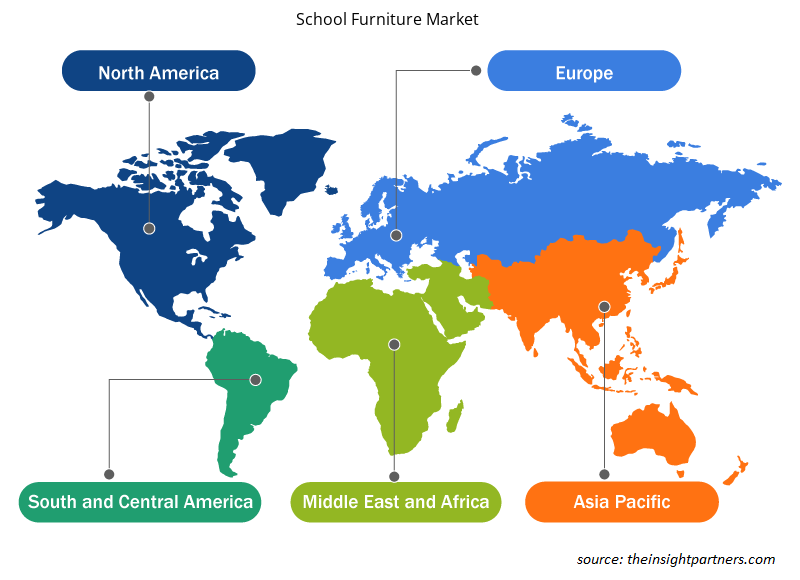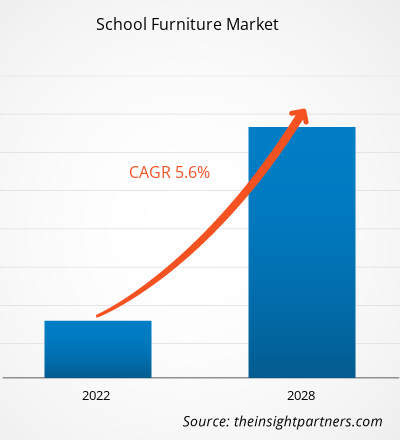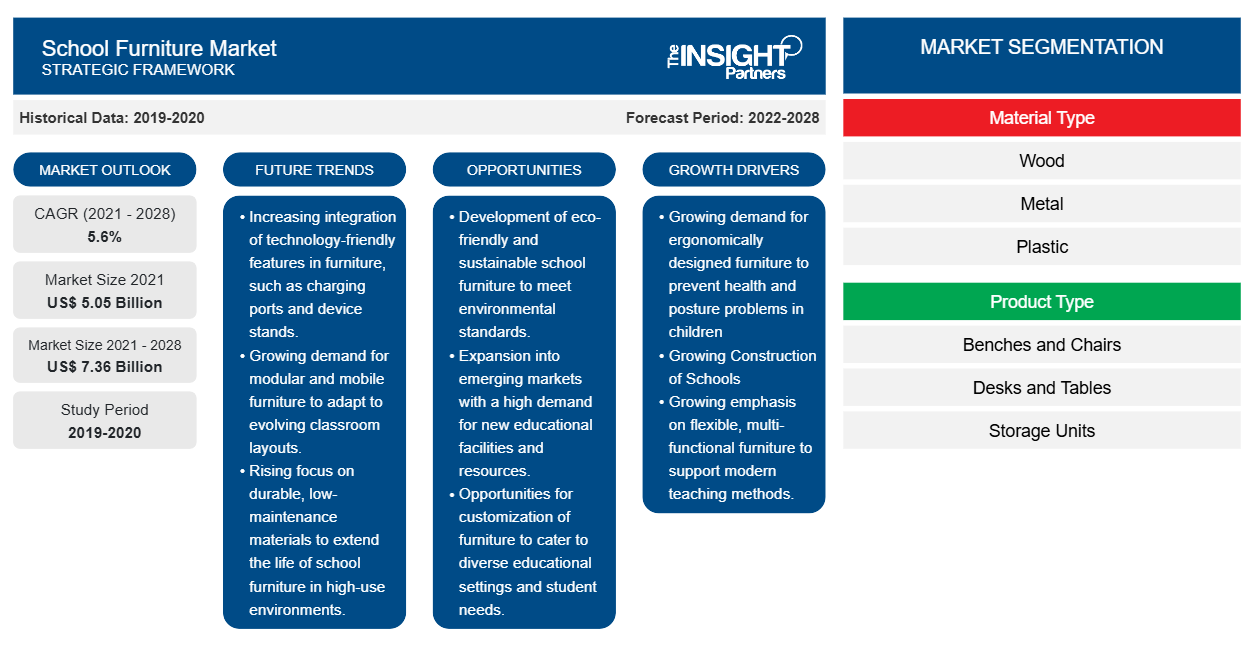[Informe de investigación] El mercado mundial de mobiliario escolar se valoró en US$ 5.047,95 millones en 2021; se espera que crezca a una CAGR del 5,6% entre 2022 y 2028.
El mobiliario escolar, que incluye estanterías, taquillas, armarios, pizarrones, escritorios, sillas, archivadores y armarios de almacenamiento, y equipos de laboratorio, se fabrica con materiales resistentes, fáciles de usar y de alta calidad, como madera, metales, tableros de fibra de densidad media (MDF) y plásticos. El mobiliario escolar está diseñado de manera que garantice el bienestar físico y mental, lo que permite a los estudiantes concentrarse en los estudios con todo su potencial. También ayuda a mejorar la flexibilidad y la productividad general de los profesores y los estudiantes, al tiempo que transforma el espacio físico en un entorno de aprendizaje dinámico.
La creciente demanda de muebles diseñados ergonómicamente para prevenir problemas de salud y postura en los niños es el factor clave que impulsa el mercado. Crear entornos de aprendizaje que mantengan a los estudiantes concentrados y cómodos se ha convertido en uno de los principales objetivos de los educadores, lo que influye positivamente en el mercado mundial del mobiliario escolar . Con la nueva era de estilos de enseñanza integrales, interactivos y dinámicos, como el aprendizaje combinado y las aulas invertidas, se ha vuelto necesario contar con muebles portátiles y ajustables que se puedan reconfigurar fácilmente.
Personalice este informe según sus necesidades
Obtendrá personalización en cualquier informe, sin cargo, incluidas partes de este informe o análisis a nivel de país, paquete de datos de Excel, así como también grandes ofertas y descuentos para empresas emergentes y universidades.
-
Obtenga las principales tendencias clave del mercado de este informe.Esta muestra GRATUITA incluirá análisis de datos, desde tendencias del mercado hasta estimaciones y pronósticos.
Además, se están introduciendo varias materias primas para la producción de muebles, y estos materiales distintos han demostrado ser más sostenibles, duraderos y estables que los tradicionales, lo que añade impulso al crecimiento del mercado. Los productores utilizan materiales como madera procesada o de ingeniería, plástico moldeado y laminado de alta presión para fabricar bancos, sillas y mesas para aulas y escuelas. Los muebles con opciones de almacenamiento adicionales actúan como una táctica de ahorro de espacio en aulas más pequeñas y compactas, y la demanda de los mismos ha observado un aumento significativo en los últimos años. Por ejemplo, CBT Supply Dba Smartdesks produce mesas y sillas inteligentes con opciones apilables y aplicaciones multifuncionales para aulas y oficinas. Por lo tanto, la creciente demanda de muebles flexibles impulsará el crecimiento del mercado durante el período de pronóstico.
Perspectivas del mercado
Creciente construcción de escuelas
Se espera que la construcción de escuelas en todo el mundo aumente debido al rápido crecimiento de la población. El creciente enfoque en el sector educativo en las áreas urbanas y rurales y los esquemas de educación primaria obligatoria proporcionados por los gobiernos de todo el mundo están impulsando el crecimiento de la construcción de escuelas. Según el Centro de Presupuesto y Prioridades Políticas, en 2018, alrededor de US$ 98.9 mil millones se gastaron en proyectos de infraestructura educativa en América del Norte, lo que indica un aumento del gasto de casi el 10% desde 2017. Con el aumento de las instalaciones escolares, las aulas superpobladas, los cambios en los códigos de seguridad de la construcción y los avances tecnológicos a nivel mundial, los funcionarios se enfrentan al dilema de invertir en nueva infraestructura o modernizar las existentes. Los gobiernos y las sociedades de todo el mundo se esfuerzan por desarrollar sus sistemas educativos y garantizar que todos los estudiantes tengan la oportunidad de ir a la escuela y adquirir las habilidades y el conocimiento necesarios para llevar una vida productiva y saludable. Para mejorar la calidad educativa, se debe modernizar la infraestructura educativa.
Además, el aumento de la matrícula de estudiantes en todo el mundo ha impulsado la demanda de mesas y sillas para las aulas, ya que son necesarias para el funcionamiento de las escuelas. El aumento de la adopción de materias primas no convencionales para el mobiliario de las aulas está dando lugar a renovaciones, colaboraciones y mobiliario ergonómico para las aulas. Varias escuelas están sustituyendo progresivamente el mobiliario escolar tradicional por una infraestructura estéticamente atractiva para hacer agradable el entorno del aula. La introducción de sillas giratorias con características ergonómicas ha sido una incorporación reciente en muchas escuelas.
Información sobre el tipo de material
Según el tipo de material, el mercado del mobiliario escolar se segmenta en madera, metal, plástico y otros. En 2021, el segmento de madera dominó el mercado del mobiliario escolar.
Fleetwood Furniture, Herman Miller, Inc., KI, Steelcase Inc., Virco, Inc., Scholar Craft, Global Furniture Group, Educan, Ven-Rez y Mitybilt se encuentran entre los actores clave que operan en el mercado del mobiliario escolar. Los principales actores están adoptando diversas estrategias, como fusiones y adquisiciones y lanzamientos de productos, para expandir su presencia geográfica y su base de consumidores.
Informe Destacado
- Tendencias progresistas en la industria del mobiliario escolar para ayudar a los actores a desarrollar estrategias efectivas a largo plazo
- Estrategias de crecimiento empresarial adoptadas por las empresas para asegurar el crecimiento en los mercados desarrollados y en desarrollo
- Análisis cuantitativo del mercado de mobiliario escolar de 2021 a 2028
- Estimación de la demanda de mobiliario escolar en diversas industrias
- Análisis PEST para analizar los cambios políticos, económicos, socioculturales y tecnológicos en el entorno empresarial.
- Desarrollos recientes para comprender el escenario competitivo del mercado y la demanda de mobiliario escolar
- Tendencias y perspectivas del mercado junto con los factores que impulsan y restringen el crecimiento del mercado del mobiliario escolar
- Estrategias que sustentan el interés comercial en relación al crecimiento del mercado de mobiliario escolar, ayudando en el proceso de toma de decisiones
- El tamaño del mercado de mobiliario escolar en varios nodos del mercado
- Descripción detallada y segmentación del mercado de mobiliario escolar, así como su dinámica industrial.
El "Pronóstico del mercado de mobiliario escolar hasta 2028" es un estudio especializado y profundo de la industria de productos químicos y materiales, que se centra en el análisis de las tendencias del mercado de mobiliario escolar. El informe tiene como objetivo proporcionar una descripción general del mercado con una segmentación detallada del mercado. El mercado de mobiliario escolar se clasifica en función del tipo de material, el tipo de producto y el canal de distribución. Según el tipo de material, el mercado se segmenta en madera, metal, plástico y otros. Según el tipo de producto, el mercado se bifurca en residencial y comercial e industrial. En términos de canal de distribución, el mercado se divide en tiendas especializadas, venta minorista en línea y contratos/licitaciones.
Perspectivas regionales del mercado del mobiliario escolar
Los analistas de Insight Partners explicaron en detalle las tendencias y los factores regionales que influyen en el mercado de mobiliario escolar durante el período de pronóstico. Esta sección también analiza los segmentos y la geografía del mercado de mobiliario escolar en América del Norte, Europa, Asia Pacífico, Oriente Medio y África, y América del Sur y Central.

- Obtenga datos regionales específicos para el mercado de mobiliario escolar
Alcance del informe sobre el mercado de mobiliario escolar
| Atributo del informe | Detalles |
|---|---|
| Tamaño del mercado en 2021 | 5.050 millones de dólares estadounidenses |
| Tamaño del mercado en 2028 | 7.360 millones de dólares estadounidenses |
| CAGR global (2021-2028) | 5,6% |
| Datos históricos | 2019-2020 |
| Período de pronóstico | 2022-2028 |
| Segmentos cubiertos |
Por tipo de material
|
| Regiones y países cubiertos |
América del norte
|
| Líderes del mercado y perfiles de empresas clave |
|
Densidad de actores del mercado de mobiliario escolar: comprensión de su impacto en la dinámica empresarial
El mercado de mobiliario escolar está creciendo rápidamente, impulsado por la creciente demanda de los usuarios finales debido a factores como la evolución de las preferencias de los consumidores, los avances tecnológicos y una mayor conciencia de los beneficios del producto. A medida que aumenta la demanda, las empresas amplían sus ofertas, innovan para satisfacer las necesidades de los consumidores y aprovechan las tendencias emergentes, lo que impulsa aún más el crecimiento del mercado.
La densidad de actores del mercado se refiere a la distribución de las empresas o firmas que operan dentro de un mercado o industria en particular. Indica cuántos competidores (actores del mercado) están presentes en un espacio de mercado determinado en relación con su tamaño o valor total de mercado.
Las principales empresas que operan en el mercado de mobiliario escolar son:
- Muebles Fleetwood
- Herman Miller, Inc.
- KI
- Fabricante: Steelcase Inc.
- Virco, Inc.
Descargo de responsabilidad : Las empresas enumeradas anteriormente no están clasificadas en ningún orden particular.

- Obtenga una descripción general de los principales actores clave del mercado de mobiliario escolar
Perfiles de empresas
- Muebles Fleetwood
- Herman Miller, Inc
- KI
- Fabricante: Steelcase Inc.
- Virco, Inc.
- Artesanía académica
- Grupo de muebles global
- Educar
- Ven-Rez
- Mitybilt
- Análisis histórico (2 años), año base, pronóstico (7 años) con CAGR
- Análisis PEST y FODA
- Tamaño del mercado, valor/volumen: global, regional y nacional
- Industria y panorama competitivo
- Conjunto de datos de Excel
Informes recientes
Testimonios
Razón para comprar
- Toma de decisiones informada
- Comprensión de la dinámica del mercado
- Análisis competitivo
- Información sobre clientes
- Pronósticos del mercado
- Mitigación de riesgos
- Planificación estratégica
- Justificación de la inversión
- Identificación de mercados emergentes
- Mejora de las estrategias de marketing
- Impulso de la eficiencia operativa
- Alineación con las tendencias regulatorias























 Obtenga una muestra gratuita para - Mercado de mobiliario escolar
Obtenga una muestra gratuita para - Mercado de mobiliario escolar